Why consider a buffer strip?
Lawns require a lot of care and maintenance, especially on the edges next to the sidewalk. Who hasn’t dealt with dry patches next to the sidewalk? Or had unsightly burn spots where dogs frequently pee on the lawn edge? Or had thatch build up that impedes pop-up sprinklers? Or have weeds constantly popping up along the lawn edge? If you’d love to keep your lawn but are tired of some of these maintenance headaches and are looking for an eco-friendlier option that will conserve water and prevent water pollution, we have the perfect solution for you – buffer strips!
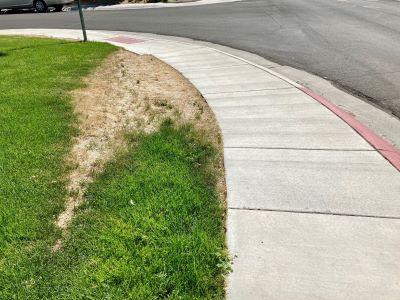
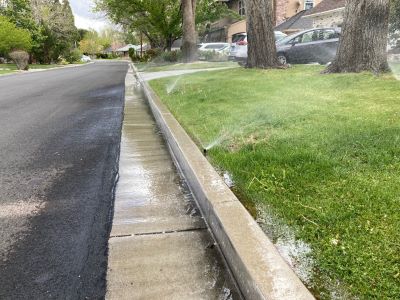
Caption: Unsightly dry patches on a lawn edge (left) and irrigation runoff (right) are common when lawns are placed next to sidewalks or other paved surfaces. Credit: Carrie Jensen
When lawn sprinklers are located next to sidewalks or on steep slopes, water is more likely to run off these surfaces, wasting water and increasing your water bill. Irrigation runoff may carry fertilizers and pesticides from your lawn into storm drains, which flow directly to natural waterways.
- Excess fertilizers can cause algae blooms, which deplete the water of oxygen, degrading the conditions for fish and other aquatic species.
- Algae blooms produce toxins that make the water unsafe to drink or recreate in.
- Pesticides can also negatively impact aquatic species, such as mayflies.
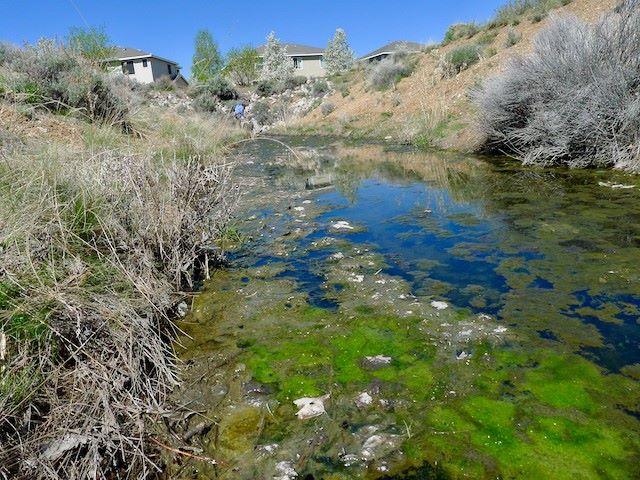
Caption: Algae bloom in local drainage in the Reno/Sparks area. Credit: Carrie Jensen
What are buffer strips?
Buffer strips are areas between the lawn and the sidewalk (or any other paved surface) that capture runoff from sprinklers. A buffer area can be as simple as a strip of rock mulch or may contain native and drought-tolerant plants.
- Buffer strips are best to include in a new landscape but relatively easy to retrofit for existing landscapes.
- Buffer strips add curb appeal and visual interest to yards
- Buffer strips are cost-effective because they reduce water use and lawn edge maintenance.
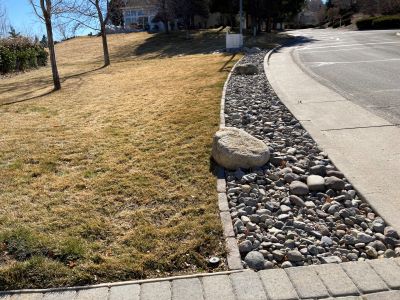

Examples of buffer strips that use rock mulch (left) or plants (right) between the lawn and sidewalk. Credit: Carrie Jensen
Design Considerations
Buffer strip design parameters are simple. Buffer strips should be 2 to 4 feet wide. They can be filled with many different mulches and plants.
Mulches:
- Consider gravel or larger rock mulches.
- Avoid decomposed granite, especially on slopes, because it can easily erode and wash onto sidewalks.
- Permeable paving can be used if you’re trying to create a buffer between a narrow sidewalk and lawn parking strip, where people may step out of their cars.
Plants:
Native and drought-tolerant plants are good choices because they:
- Are adapted to our high desert climate conditions and can survive the harsh conditions next to a sidewalk.
- Require less water, fertilizers and pesticides.
- Have extensive roots to help absorb and filter irrigation runoff.
Good options include sulfur buckwheat (Eriogonum umbellatum), yarrow (Achillea millefolium), lavender (Lavendula angustifolia), silver mound sage (Artemisia schmidtiana ‘Silver Mound’), blanketflower (Gaillardia grandiflora), and blue grama (Bouteloua gracilis).
Mature plant heights should not exceed 2.5 feet (be sure to check local codes as this height may vary) to maintain sight lines from driveways and street corners. Mature plant width should not exceed the planting area.
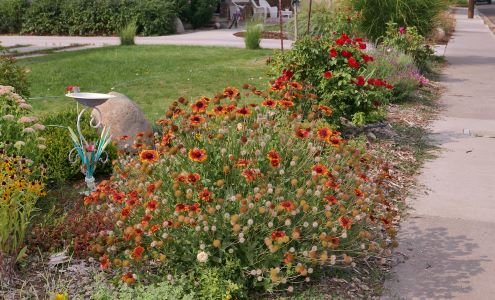
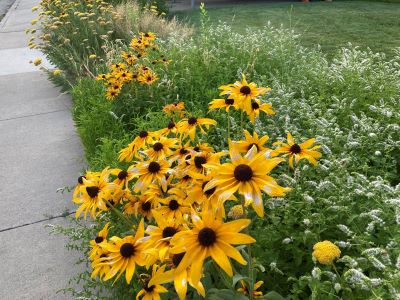
Caption: Examples of planted buffer strips in yards in the Reno/Sparks area. Credit: Carrie Jensen
How to remove lawn and install a buffer strip
- The fastest method to remove lawn is to use a sod cutter. This tool will cut the lawn out in strips that you can either compost or dispose of offsite.
- A sod cutter reduces the chance that the grass will grow back.
- It helps ensure that the soil level next to the sidewalk is slightly lower, so dirt and mulch won’t slough off onto the sidewalk.
- Consider installing edging between the new lawn boundary and the buffer strip for a look neat and tidy lawn edge.
- Do not use sod cutters near tree root systems.
How to water a buffer strip
Once the grass is removed from the buffer strip area, you need to revise your irrigation system. The plants in the buffer strip will require far less water than the remaining lawn, so the irrigation should be broken into two watering zones that reflect the different water needs of the lawn and the buffer strip.
- Move and adjust lawn sprinklers to the new boundary of the lawn area.
- For planted buffer strips, install a drip irrigation system to meet the lower water requirements for this area.
- Place your drip irrigation on a separate valve and program in the irrigation controller. This allows you to adjust watering depth and frequency over time.
- Native and drought-adapted plants will need frequent watering in the first few years to establish their roots systems. Once established, they need only occasional watering, usually once a week during the summer months.
Since each irrigation system is different, it may be best to work with a landscape professional to determine the most efficient retrofit. You can find local Qualified Water Efficient Landscapers to hire on the QWEL website.
Maintenance Considerations
Buffer strips are very low maintenance, but there are a few things to consider.
- Make sure mulch doesn’t slough off onto the sidewalk, especially if the buffer strip is on a slope. (If you lowered the soil level during turf removal, this shouldn’t be a big problem.)
- Prune plants if they grow too tall (over 3 feet) or hang over onto the sidewalk to maintain sightlines and clear access to sidewalks. Choosing the right plant and giving it the proper area to grow will often minimize this maintenance.
- Regularly check your irrigation for leaks and proper function.
This material is based upon work supported by the National Institute of Food and Agriculture, U.S. Department of Agriculture, under Award No. 2021-70006-35488. Any opinions, findings, conclusions, or recommendations expressed in this publication are those of the author(s) and do not necessarily reflect the view of the U.S. Department of Agriculture.


